Wisconsin locals anticipate the pleasant, cheerful blossoms of the warmer weather months. They also anticipate the annual bird migrations that lend themselves to a season of bird-watching. In fact, bird watching is getting more and more popular across the country to the point that it is now regarded as the pastime with the quickest rate of growth. Every year, almost 50 million Americans decide to go bird watching in order to take a tranquil break from the hustle and bustle of everyday life. If you’re in the Badger State this summer, here are Wisconsin’s 10 best bird-watching spots.
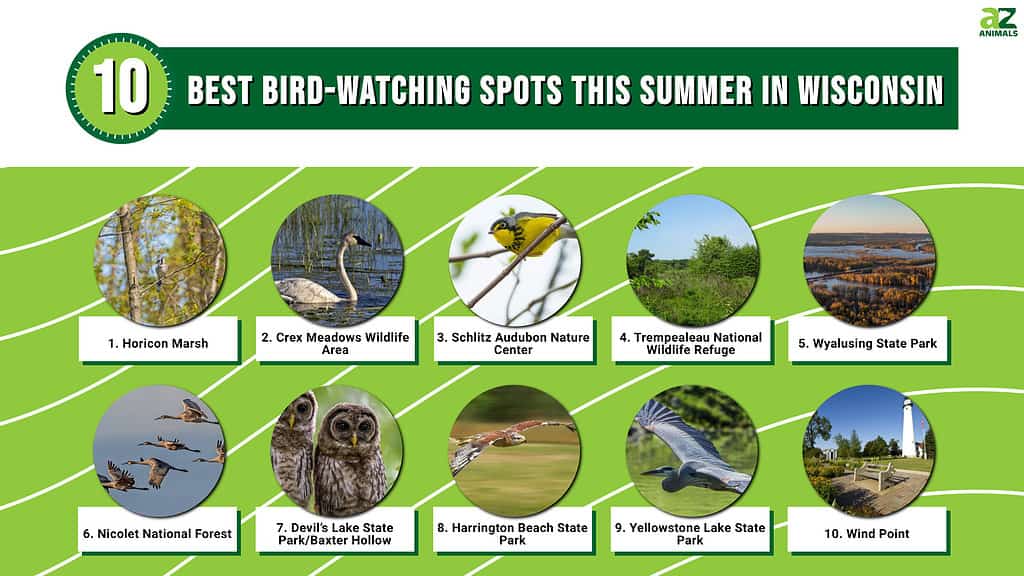
Horicon Marsh
Horicon Marsh is the biggest cattail marsh in the United States, covering 33,000 acres. After being abandoned and emptied for farmland in the early 1900s, this marsh is undergoing rehabilitation. Although the marsh is mainly kept as a waterfowl area, a wide diversity of other species call it home.
The spring and autumn migration of Canada geese, which frequently numbers more than 200,000 birds, is arguably best known for this wetland. Over 300 species have been spotted here throughout the years, and this marsh frequently draws some of Wisconsin’s rarest bird species.
In order to conserve the animals for which it has been established, public access is restricted in this area of the marsh since it is a national wildlife refuge. The public has access to most of the state’s territory. Canoeing or using a boat with a shallow draft are two of the greatest methods to explore this region.

In addition to Canadian Geese, you’ll find Blue Jays at Horicon Marsh in Wisconsin too!
©Wildnerdpix/Shutterstock.com
Crex Meadows Wildlife Area
Crex Meadows is a more than 30,000-acre property in western Burnett County, north of Wisconsin’s Grantsburg Village. It is renowned for hosting rare and nesting species, but it is also easily accessible, with many of the dikes and flowages accessible through two county highways and more than 40 miles of municipal roads. Wetlands and scrub prairies are parts of the habitat.
Phantom Lake Flowage is the refuge in the area’s hub, where you can see Sharp-tailed Grouse and Bald Eagles. Starting in the middle of May through the beginning of July, the pumphouse portion of Reed’s Lake sedge marsh, where you can see Yellow Rails, Le Conte’s Sparrows, Nelson’s Sharp-tailed Sparrows, American Bitterns, and Sandhill Cranes, are all strongly recommended attractions. Fish Lake Wildlife Area nearby,
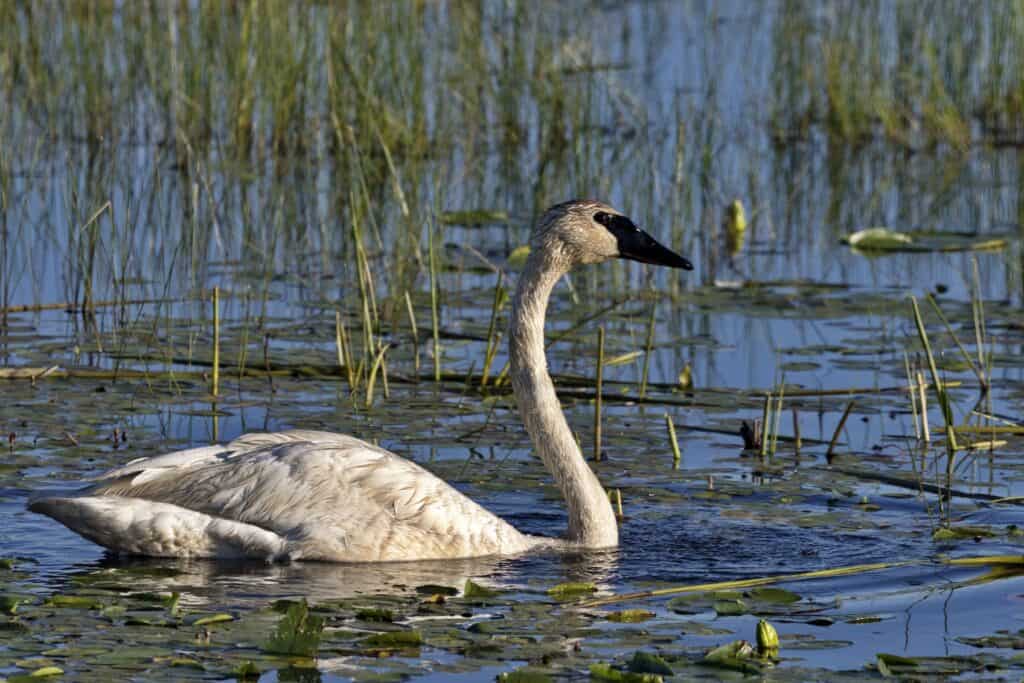
Crex Meadows is home to waterfowl like Trumpeter Swans.
©Florence-Joseph McGinn/Shutterstock.com
Schlitz Audubon Nature Center
Take out your binoculars! Due to the variety of habitats at Schlitz Audubon and its location along a migratory flyway on Lake Michigan, a great variety of bird species may be seen there. Thirty-six warbler species are among the 261 species that have been seen at Schlitz Audubon since 1974.
The connected uplands, which offer an essential habitat for migratory, breeding, and overwintering birds, as well as Lake Michigan’s habitat for some ducks, make this place part of a declared Important Bird Area. Early in the morning, when birds singing is at its liveliest, or early in the evening when the birds are eating before their nightly migration, are the ideal times of day to visit these birding paths.

Warblers are a sought-after bird to spot at the
Schlitz Audubon Nature Center
.
©Paul Reeves Photography/Shutterstock.com
Trempealeau National Wildlife Refuge
The 1936-founded Trempealeau National Wildlife Refuge is tucked away along the Mississippi River’s powerful eastern shore. Travelers are drawn to the refuge by the Great River Scenic Byway’s beautiful scenery. The diversity of animal species is supported by the undulating plains, abundant wetlands, and bottomland woods.
Both ducks and other species can find resting and feeding spots in these river backwaters. Wood frog and spring peeper symphonies and multicolored warblers fly and dart about the refuge when it becomes quite active. As great blue herons and great egrets wait on the seashore searching for food, black terns flutter and fly over the water.
Beautiful blooms cover the plains, where singers look for seeds and monarch butterflies glide to milkweed plants. Monarch butterflies and migratory birds begin their long trips to their wintering habitats because they anticipate food shortages over the winter. They throng the refuge along the road to unwind and eat. In bare settings with less foliage coverage during the winter, raptor birds are easier to see.
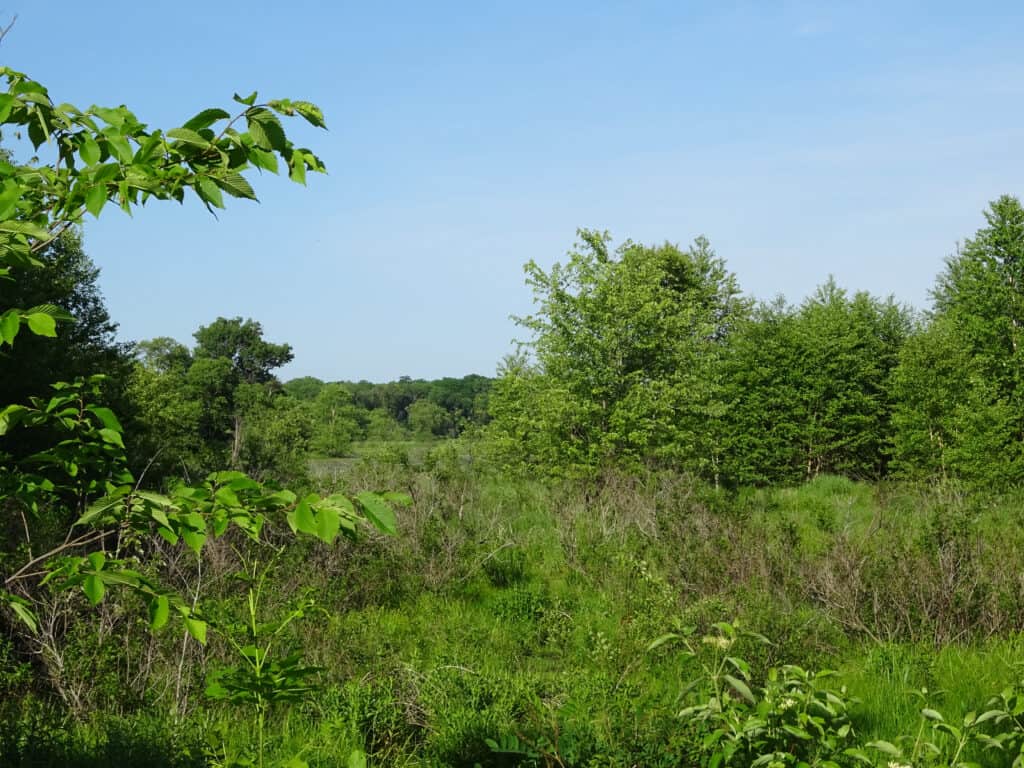
Trempealeau National Wildlife Refuge
©Maarten Daams/Shutterstock.com
Wyalusing State Park
Overlooking the meeting of the Wisconsin and Mississippi Rivers lies Wyalusing State Park. Numerous species use the Mississippi as a key migratory path, and the rocky bluffs in this gorgeous landscape make it a wonderful location for a springtime trip. Watch hawks, warblers, especially yellow-throated, and a variety of other species, as well as some early-season wildflowers.
This park is one of the gems of the Wisconsin State Parks department and has a visitor’s center, indoor and outdoor campsites with restrooms, an astronomical observatory, and historical markers. Visitors to an astronomy observatory will include birders. Henslow’s Sparrows often spend the summer here, making it one of the best spots in the state to see them.
This grassland is a fantastic site to observe Orchard Orioles, many different Sparrows, and strutting American Woodcocks during migration. Birdwatchers will finally arrive at Point Overlook after exploring the plains and savanna for birds. Birdwatchers should listen for chirping Yellow-throated Warblers in the pine stand as they make their way from the parking lot to the viewpoint.
One of the greatest spots in the area to discover this species is often here. Be careful to listen for species like the Great-crested Flycatcher, Yellow-billed Cuckoo, and Black-billed Cuckoo once you reach the overlook.
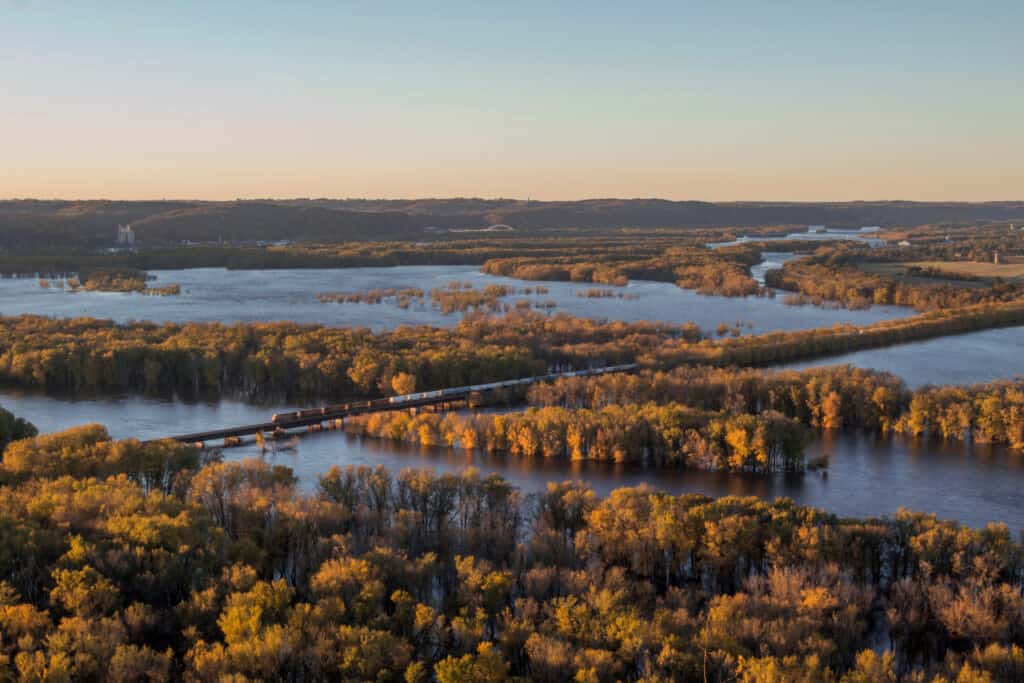
Wyalusing State Park is where bird watchers can spot a variety of species, such as the Great-crested Flycatcher, Yellow-billed
Cuckoo
, and Black-billed Cuckoo.
©Sam Wagner/Shutterstock.com
Nicolet National Forest
In 1989, the Nicolet National Forest and the Northeastern Wisconsin Audubon Society jointly developed the Halley Creek Bird Trail. This walk takes you through four different habitat types, each having a specific bird species that are unique to this area. The ideal seasons to watch the many bird species are early spring and early summer. The forest’s rich aspen, maple, pine, cedar, spruce, and fir trees surround more than 1,200 lakes and rivers, providing birdwatchers with the ideal setting.
Nicolet National Forest is home to many North Woods species, from the secretive Spruce Grouse to vibrant warblers. Traveling on forest roads might be a nice way to explore the region east of Three Lakes. Ruffed Grouse, Spruce Grouse, Northern Goshawk (rare), Yellow-bellied Sapsucker, Olive-sided Flycatcher, Yellow-bellied Flycatcher, Blue-headed Vireo, Gray Jay, Boreal Chickadee, Golden-crowned Kinglet, and numerous other species may be spotted here.
The Hooded Merganser, Common Loon, American Bittern, Osprey, Northern Harrier, Sandhill Crane, American Woodcock, and Sedge Wren are among the species that nest here.
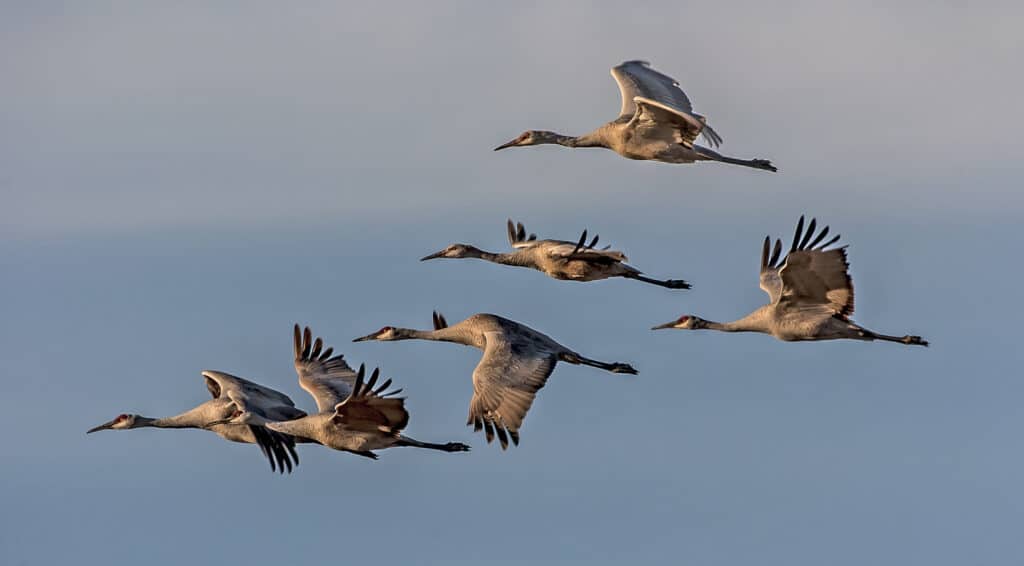
In Nicolet National Forest, be on the lookout for sandhill cranes.
©Tom Zeman/Shutterstock.com
Devil’s Lake State Park/Baxter Hollow
In recent years, Devil’s Lake State Park in the Baraboo Hills has seen more than 3 million visits. During the warmer months, the park may get very busy. Fewer people call Natural Bridge State Park, 20 miles to the southwest, which is home to Wisconsin’s greatest natural arch. The spectacular hollows and draws in the Driftless Area, where the highlands are located, are a byproduct of erosion by wind and water.
In the park, more than 100 different bird species nest, and during migration season, that number increases significantly. In this natural region to the west of Devil’s Lake State Park, you’ll see a lot of the same plants and animals.
Wood Duck, Wild Turkey, Broad-winged Hawk, Yellow-billed Cuckoo, Black-billed Cuckoo, Barred Owl, Pileated Woodpecker, Acadian Flycatcher, Yellow-throated Vireo, Wood Thrush, Ovenbird, and more are among the species that breed there.
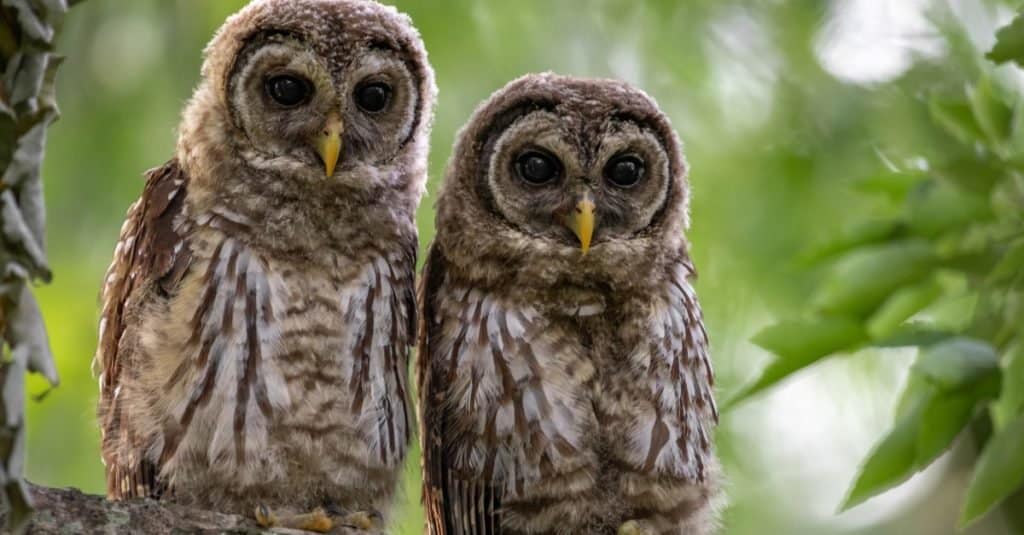
Barred owls are often spotted by birdwatchers at Devil’s Lake State Park.
©iStock.com/Harry Collins
Harrington Beach State Park
One of the greatest spots to see birds in the state, this 637-acre park features a mile of Lake Michigan coastline with a bird list of 256 species. Waterfowl migrate offshore in stunning quantities throughout the spring and fall seasons. Nearly all warbler species decorate the trees in the hardwood woods and lowland white cedar swamps in the spring.
Hawk migrations in the fall are magnificent as they travel south along the security of the seashore. It’s fun to explore the marshes, open fields, and shrubbery. The whole property is accessible through hiking paths. For those looking for excitement, the park includes a visitor center, boardwalks, geocaching, or a cool dip in Quarry Lake.

Hawk migrations are highly anticipated at
Harrington Beach State Park
.
©pr2is/Shutterstock.com
Yellowstone Lake State Park
Yellowstone Lake State Park in southern Wisconsin has a variety of habitats and nesting species, making it one of the greatest birding locations in the state. The park has a 455-acre lake, which is frequented by migratory Common Loon, grebes, Double-crested Cormorant, American White Pelican, Osprey, gulls, and terns from autumn through spring.
The bald eagle is always present. Many migratory shorebirds, including Sora, may be found in marshy areas with shallow water, along with breeding Great Blue Heron, Green Heron, and Marsh Wren birds.
Over 4,000 small brown bats, which sleep in 31 bat homes around the park, spend the summer at Yellowstone Lake. The area has grassland and a forest as well. Wood Duck, Wild Turkey, Barred Owl, Eastern Whip-poor-will, Willow Flycatcher, White-eyed Vireo, Yellow-throated Vireo, Sedge Wren, Blue-winged Warbler, Grasshopper Sparrow, Henslow’s Sparrow, Dickcissel, and Bobolink are some more species that nest in trees.
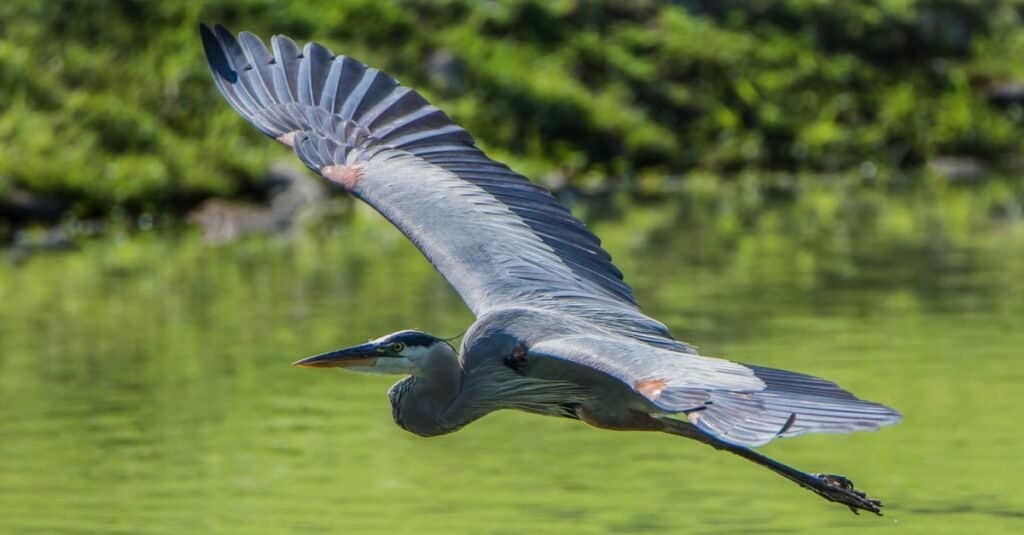
Be on the lookout for Great Blue Herons at
Yellowstone Lake State Park
.
©Tom Franks/Shutterstock.com
Wind Point
This granite outcrop extends into Lake Michigan to the north of the city. At practically any time of the year, it’s a great location to see a variety of uncommon species. Warblers, sparrows, thrushes, and numerous other species find cover in the Point’s ravines and forested regions during thunderstorms. Along the lakefront, Red-throated Loons, Whimbrels, Greater Black-backed, Sabine’s, and Franklin’s Gulls graze.
You may also take in the scenery from the historical lighthouse, and when driving throughout the park, keep an eye out for any intriguing species. In addition to the area around the lighthouse, birdwatchers may also view the water from the golf course parking lot, which is located half-mile south.

In addition to birds, be on the look out for the Wind Point Lighthouse while you’re in Wind Point.
©John Brueske/Shutterstock.com
Summary of Wisconsin’s 10 Best Bird-Watching Spots
| Number | Spot | Location |
|---|---|---|
| 1 | Horicon Marsh | Mayville |
| 2 | Crex Meadows Wildlife Area | western Burnett County |
| 3 | Schlitz Audubon Nature Center | on Lake Michigan |
| 4 | Trempealeau National Wildlife Refuge | Mississippi River’s eastern shore |
| 5 | Wyalusing State Park | where the Mississippi River and Wisconsin River meet |
| 6 | Nicolet National Forest | Northwoods |
| 7 | Devil’s Lake State Park/Baxter Hollow | Baraboo Hills |
| 8 | Harrington Beach State Park | Lake Michigan coastline |
| 9 | Yellowstone Lake State Park | southern Wisconsin |
| 10 | Wind Point | Lake Michigan |
The photo featured at the top of this post is © Florence-Joseph McGinn/Shutterstock.com
Thank you for reading! Have some feedback for us? Contact the AZ Animals editorial team.






